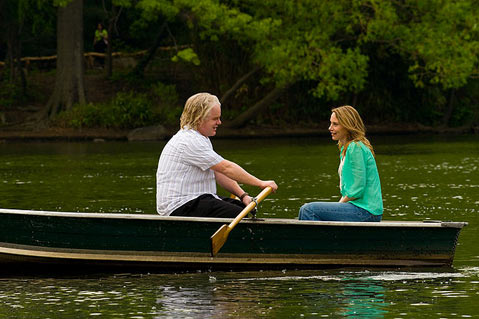Jack Goes Boating
Philip Seymour Hoffman, Amy Ryan, and John Ortiz star in a film written by Bob Glaudini, based on his stage play, and directed by Hoffman.

Philip Seymour Hoffman deserves some special award for his uncanny ability to travel roads less taken. His cast of characters over the years has been on the eccentric side, to be sure, including his volatile thug in Punch Drunk Love, the suffering sibling in The Savages, and the lovelorn gas-sniffing disaster in Love Liza. Enter the mild-mannered N.Y.C. limo driver in love in the slow-moving, understated, but wholly engaging Jack Goes Boating, which doubles as Hoffman’s directorial debut. This marks the point in his filmography at which Hoffman gets happy, or at least finds the onramps to the makings thereof.
In this patient, poetic, and languidly comic film based on Bob Glaudini’s stage play, Hoffman is Jack, a gentle soul in an ungentle world. He seeks out positive vibrations where he can find them, in reggae anthems and his much-desired love interest (a goofily charming Amy Ryan). At her behest, obliquely, he takes refuge in life missions related to big events: He learns to swim from his best and only friend (John Ortiz) so he can take his belle-to-be boating after the winter; he learns to cook in preparation for a dinner party, which becomes a cathartic flashpoint in the simple arc of the story.
Like too few American films, even from the indie film sector, Jack Goes Boating is an exercise in fluidity. Images of water, from the swimming pool to the metaphorical motif of successful boating, float through our protagonist’s head and through the story itself.
Texture and pace are key factors, from Hoffman’s tender (building to momentarily tumultuous) acting approach to cinematographer W. Mott Hupfel III’s uncommonly luminous lenswork to the mood-enhancing music of Grizzly Bear, Fleet Foxes, and Bill Evans’s “Peace Piece.” That tune itself, which fully plays out over the end credits, somehow summarizes the emotional experience of the narrative itself. Evans’s piece issues its swaying improvisations over two major chords for much of the song, but becomes complicated by dissonant asides later in the piece, then finds its positive vibe again at the end, but still with the patina of pain gone by. So goes this lovely, mostly lilting urban folk tale of a film.



